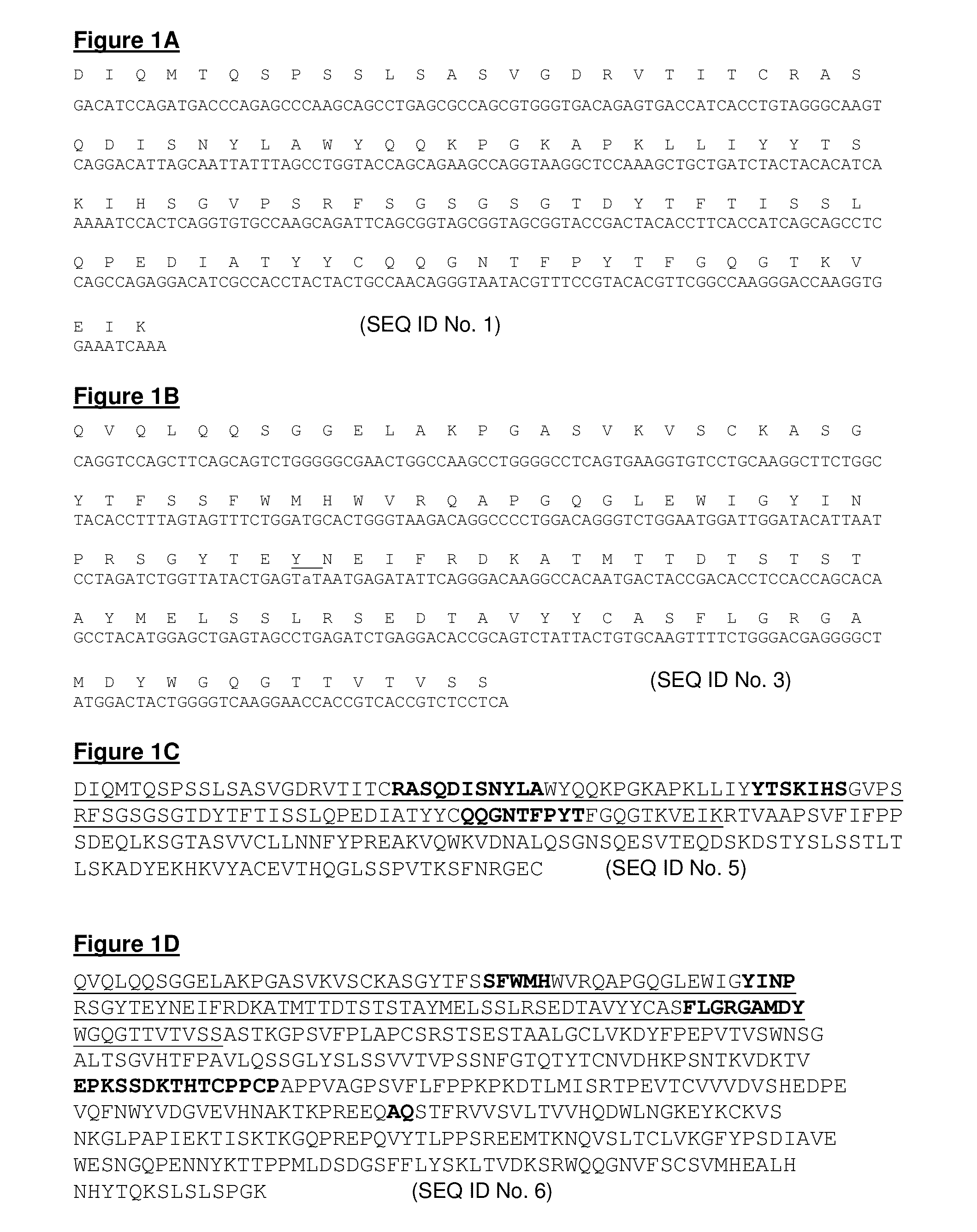Engineered anti-alpha V-integrin hybrid antibodies
a hybrid antibody and alpha v-integrin technology, applied in the field of engineered antibodies, can solve the problems of non-tolerable loss, reduced expression, binding affinity etc., and further problems to be solved, so as to reduce immunogenicity, reduce immunogenicity, and reduce immunogenicity
- Summary
- Abstract
- Description
- Claims
- Application Information
AI Technical Summary
Benefits of technology
Problems solved by technology
Method used
Image
Examples
example 1
Construction and Expression of the Engineered Antibodies According to the Invention
[0179]In order to reduce immunogenicity in man, DI-17E6 (EMD 525797) was made by de-immunization and genetic engineering of murine 17E6.
[0180]Source antibody was monoclonal mouse antibody 17E6 as described earlier. This antibody was generated from mice immunized with purified human αvβ3. Spleen lymphocytes from immunized mice were fused with murine myeloma cells and one of the resulting hybridoma clones produced monoclonal antibody 17E6 (see for example EP0719859). The hybridmoa cell line producing said andibody was deposited under DSM ACC2160.
[0181]In principal the variable regions of the light (VL) and heavy (VH) chains of murine 17E6 were analyzed in silico with the so-called de-immunization methodology (WO 98 / 52976, WO 00 / 34317 and WO 02 / 069232) to remove potential T-cell epitopes. De-immunized VH and VL sequences were designed to retain those amino acids from the murine sequence critical for bind...
example 2
Generation of a Diversity of Antibody Mutations to Find Out Optimum Expression and Binding Affinity Patterns
[0204]Summary of data on increasing expression level of DI-17E6 by reengineering
[0205]Problem in expression: The expression levels of the deimmunized versions were even lower than that of the chimeric:
[0206]
TransientNS0 fromin PER.C6ECACCNS0-LDch17E6-g2h, g4h and ~3-4 ug / ml~15 ug / mlNDg4h(NtoQ)deImm17E6 VH33-VL60.2-0.3 ug / ml~1 mcg / ml~1.6 ug / mlg2h(FNtoAQ)(96-well)deImm17E6 VH33-VL49-0.7 ug / ml~3 ug / ml~10 ug / mlg2h(FNtoAQ)
[0207]To increase the expression level of delmm17E6 VH33-VL49 / VL60.2-g2h(FN to AQ), we mutated:
a.) C60 to S and Y in CDR2 of VH.
b.) GEM back to DGTV in VL to restore a H-bond network but a potential weak T cell epitope.
c.) V20M reversion in VH
[0208]The results of two sets of transient transfection were summarized below:
Delmm 17E6 Mutant (C60S) Expression Level Vs Other 17E6 (Transient Transfection in Per.C6, 24 ug in 10 cm plate):
[0209]
Day 1Day 4DeImm 17E6[VL49 / VH...
example 3
[0231]To characterize integrin specificity of DI-17E6, ELISA, cellular ELISA and flow cytometry analysis were used, and these allowed us to identify the αv chain of integrins as the specific ligand for EMD 525797.
[0232]EMD 525797 recognizes purified αv-integrins but, as expected, had no reactivity against purified αIIbβ3. EMD 525797 also interacts with human cell lines with αv-integrins on their cell surface, independently of the associated β-chain subunit. EMD 525797 and LM609 immuno-reactivities are depicted in the following tables:
Immune-Reactivity on Purified Integrins
[0233]
αvβ3αvβ5αIIbβ3EMD 525797++−LM609+−−
[0234]Reactivity of LM609 (murine monoclonal antibody anti-αvβ3) is shown for comparison.
Immune-Reactivity on Tumor Cell Lines
[0235]
Test cellM21M21-LMeWoHT29Colo205SKBR-3A498V + B2CV-1αv-integrin patternαvβ3No αv-αvβ3αvβ6αvβ6αvβ5integrinsαvβ5αvβ5αvβ5αvβ5αvβ3αvβ1αvβ3EMD 525797+−+++++++LM609+−+−−−+−nd
[0236]Reactivity of LM609 (murine monoclonal antibody anti-αvβ3) is shown for...
PUM
| Property | Measurement | Unit |
|---|---|---|
| body weight | aaaaa | aaaaa |
| body weight | aaaaa | aaaaa |
| body weight | aaaaa | aaaaa |
Abstract
Description
Claims
Application Information
 Login to View More
Login to View More - R&D
- Intellectual Property
- Life Sciences
- Materials
- Tech Scout
- Unparalleled Data Quality
- Higher Quality Content
- 60% Fewer Hallucinations
Browse by: Latest US Patents, China's latest patents, Technical Efficacy Thesaurus, Application Domain, Technology Topic, Popular Technical Reports.
© 2025 PatSnap. All rights reserved.Legal|Privacy policy|Modern Slavery Act Transparency Statement|Sitemap|About US| Contact US: help@patsnap.com



